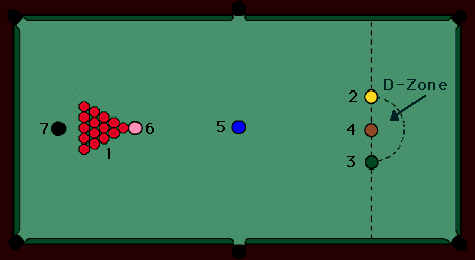

The Rules of Snooker can be found on our site along with the rules of other popular pool games, but we frequently get requests for a diagram of a snooker table rack. Sooooo, here it is.
There are 15 solid red balls each with a value of 1 point. The (other) colored balls are valued thus: Yellow (2), Green (3), Brown (4), Blue (5), Pink (6), Black (7). The cue ball is white (not shown).
A brief summary of the game is as follows:
The cue ball is placed within the "D" for the break. It is wise to use a break similar to that used in 14.1 straight pool.
Think of snooker as a game whereby sinking a red ball earns the player an opportunity to go after one of the colored balls. Therefore, the player must pocket alternately a red and then a "colored" ball.
After pocketing a red ball, the player may shoot at his choice of colored balls. If he sinks a colored ball, it is respotted to its assigned spot (diagram above), and the shooter may attempt to pocket another red ball, followed by any colored ball. All red balls stay down, but the colored balls are respotted immediately after being pocketed. Play continues this way until there are no red balls remaining on the table.
When all of the red balls have cleared from the table, the remaining colored balls are pocketed in ascending order from where the cue and object balls lie.
A player is awarded one point for each red pocketed, and the numerical value of each colored ball pocketed after his turn at the table is ended by a miss. If a shooter fouls, the opponent is awarded 7 points (no point deduction from offenders score.)
In order to enjoy the game, it will be necessary to get the complete and official rules. The above is only offered to give readers who are unfamiliar with the game a brief overview.
When you play your first game of snooker, the size of the table and the narrow pockets might intimidate you. Additionally, the corners of the rails are rounded, making it extremely difficult to run a ball down the rail to pocket it.
Although the rules are more complex than any other pocket pool game, they are easier to remember than it might seem. However, keeping a copy of the rules handy is a good idea.
If you get frustrated trying to sink a ball in the smaller pockets, just relax and try to focus on your aim. It is not as difficult as you first make it out to be. In fact, the smaller snooker balls are easier to target, and cue ball control is also more easily achieved. It just takes a little practice.
I had never played snooker until about 1972 when a friend from out of town visited me. We played 8 & 9-ball for hours, and I won most games easily. Later I visited him (in Danville, VA) where he took me to a snooker table. It was the first I had seen. He beat me every game for several hours. Finally I made up my mind to just shoot pool and I starting winning. I realized my losses were the result of being intimidated by the table itself.
If there is a snooker table in your town, give it a try. As time passes, snooker will become more popular in the States, and you don't want to get left behind. And who knows, you might be traveling to the old country soon.